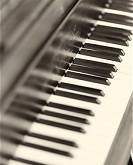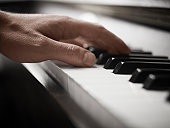
Home > Piano Scales > Fingering
|
||||
Piano Scale & Chord Fingering
Fingered piano music deems each note with a particular number that represents to one of the fingers of a hand. You can see the numbers 1-5 written above or below notes in particular songs and scales. Such numbers also represent to the five fingers while telling you which finger to press. Moreover, finger numbering for the two hands go as the follows:
Once you start playing with the use of your left hand, you will then figure that the fingering is similar for the two hands. The same fingers perform similar notes in the two triad scales, yet the numbers are reversed. Great fingering is seen as a highly treasured skill for any pianist. If you have proper piano fingering, you are allowing your fingers to perform new and good techniques, master the hardest positions, and practice the accuracy and speed needed. Training piano fingering may deem to be highly tedious at the beginning, however once you stick all through it, finger will adjust keenly. PIANO FINGERING FOR THE LEFT HAND: Scale fingering for the left hand can be a more complicated than the other. Here is an easy principle on the scale fingering: The standard scale fingering for the left hand is: 5-4-3-2-1 3-2-1 (Ascending). Play this scale fingering on: C G D E A and F. Every scale begins on the White Notes. Exception: B Scale. Standard scale fingering for the left hand is: 5-4-3-2-1; 3-2-1. ASCENDING
B Scale makes us of similar principles as the scales of the right hand start on the black notes. Making use of the fingering and placing your thumb on the white keys; it has been instructed to start B Scale with the 4 finger on B; however, it is also great to use the thumb and follow the following pattern: 1 3-2-1; 4-3-2-1. F Sharp Scale or G Flat Scale: Makes use of similar principles. The fingers 3-2 press on the set of 2 black keys and fingers 4-3-2 press on the set of 3 black keys, while the thumb presses on the white key slots. The Scale would then start off the 4 finger: 4-3-2-1; 3-2-1. SCALES STARTING ON BLACK NOTES ON THE LEFT HAND SIMPLY START ON THE 3 FINGER. B FLAT, E FLAT, A FLAT AND D FLAT, ALL BEGIN ON THE 3 FINGER.
CHORD INVERSIONS: Making use of the C chord inversions for example. It is simply all about the spacing. FIRST INVERSION C CHORD = E - G - C; Make use 5-3-1.
FIRST INVERSION CHORDS MUST MAKE USE OF FINGERING 5-3-1. This is a very simple fingering for the left hand for when performing G and C, you can then use the widest range in your hand the 3 to the thumb. SECOND INVERSION C CHORD = G - C - E; Make use of 5-2-1.
SECOND INVERSION CHORDS MUST MAKE USE OF THE FINGERING 5-2-1. G to C is the largest grouped notes. You will have to accommodate that while using the 2 finger on C, and therefore adding a lot more space between your fingers.
=> http://pianoplayerworld.com/Hanon1.html
| ||||
|
Although every attempt has been made to make information as accurate as possible, we are not responsible for any errors that may appear.
 Piano fingering is referred to as the placement of fingers on the piano
keyboard as well as the hand techniques actualized to play a piano.
Piano fingering is referred to as the placement of fingers on the piano
keyboard as well as the hand techniques actualized to play a piano.
 THE PIANO CHORD, ITS FINGERING FOR THE LEFT HAND: It has the similar
principle as the right hand, only reversed. Here is the standard idea of the
THE PIANO CHORD, ITS FINGERING FOR THE LEFT HAND: It has the similar
principle as the right hand, only reversed. Here is the standard idea of the 



